#Stéphane Pair
Explore tagged Tumblr posts
Photo

Based on that very well known video of the two guys on the mechanical bull. (I couldn’t find the original post, sadly.)
My OCs Stéphane and Lochlyn having some time together~
Also that’s probably Stéphane’s favourite shirt. Shame on you. (but the hat is Lochlyn’s)
[image ID : two men riding a mechanical bull. Stéphane, a white man wearing a red shirt, a white t-shirt with the 98′ football world cup mascot on it and blue jeans, is sittilg across from Lochlyn, his legs on top of Lochlyn’s. He’s holding onto him with one hand, and putting on his head a cowboy hat obscuring part of his face. Lochlyn, a white man with short, blond-ish hair, is facing away from the spectator, looking at Stephane. He’s wearing a white t-shirt and black pants. The background is dark brown, and there’s a light shining on them. end ID]
#my OCs#stéphane#lochlyn#name pending#pairing name is probably something stupid#blue white red or something#they are stupid#my Drawings
3 notes
·
View notes
Text
Turkkila & Versluis: “We Want To Differentiate Ourselves From Previous Years”

Earlier this month, ice dance couple Juulia Turkkila and Matthias Versluis skated in the show L'Apprenti Sorcier (The Sorcerer's Apprentice) organized in Champéry, Switzerland. The choreography was done by Salome Brunner and Stéphane Lambiel. The Finns were the only ice dancers in the show. How did they end up there?
“Last year, I edited the music for Deniss Vasiljevs' free program The Lion King,” Matthias says. This season, Matthias has done ten different music cuts for Lambiel's students.
“Towards the end of May, Stéphane asked us if we would be interested in joining the show. It was a great honor,” he continues.
“We were with an amazing group of skaters, some of the world's best. It's unique to skate with a live pianist,” Juulia shares.
In the show, Juulia and Matthias performed to Franz Liszt's Hungarian Rhapsody No 2. They presented wonderful lifts and spectacular movements. The international audience was impressed by the couple's soulful performance.

Finland's top couple has been training hard throughout the summer.
“Early May, we went to Rome for new choreography. In June, we had some vacation time and in July, we went to the Czech Republic for five weeks of summer camp,” Juulia says.
The rhythm dance theme for the 2024–25 season is Social Dancing from the 1950s–1970s.
“We chose music from the 1960s because we suspect that many teams will use disco from the 70s,” Juulia explains.
The pair found a go-go jive song that they immediately liked, and combined it with James Brown's classic I Got You.
“We wanted high energy music that the audience can recognize. There is no slow part in our rhythm dance. It is challenging,” Juulia reflects.

The couple's free dance is the Argentine Tango La Rubia Mirella, which is based on true events. The story was introduced to the couple by an Argentinian tango dancer, who worked with them on and off the ice.
“The beginning is quite soft, but the end is really strong. We want to show that we can be strong and fast. The language of movement is traditional tango, but the program is not built from typical dance movements,” Matthias shares.
Juulia plays a strong woman initially, but is used and abused by men. Matthias plays the role of a villain. The ending is dramatic.
“When there is a clear story, you have to bring in more emotion and drama,” Juulia states.

The pair's programs will first be seen in the Challenger Series competitions, followed by the Grand Prix events in Finland and China.
“We are aiming for medal positions in both GP competitions, and thus a place in the GP final. We are trying to collect world ranking points so that we can start competitions in the right groups during the Olympic season,” the couple says in unison.
With a fierce tango, Juulia and Matthias will be taking a different path this upcoming season, changing their image as classical lyrical skaters.
“We want to differentiate ourselves from previous years. A new combination lift is in the works for the free program, and the choreographic elements will be totally in character with the tango,” Juulia sums up.

#SEATED FOR THIS TANGO ❤️🌹❤️#LET’S GOOOOO ✨✨✨#Turkkila Versluis#Juulia Turkkila#Matthias Versluis#Figure Skating#Ice Skating#Ice Dance#Skating#Dance#Tango#Sport#Art#Finland#Switzerland#Team Champery#Show#Stephane Lambiel#Satoko Miyahara#Shoma Uno#Marin Honda#Koshiro Shimada#Deniss Vasiljevs#Interview
32 notes
·
View notes
Text

US Vogue October 1989
Karl Lagerfeld for Chanel Haute Couture Fall/Winter 1989-90 Collection. Lagerfeld's inspiration for this Burg wool jacket from 1989: a suit designed by Coco Chanel in 1939 and never presented. Lagerfeld's version worn by Cordula Reyer has the same long, fitted silhouette, plus patch pockets. He pairs it with a short draped chiffon skirt (Hurel). Fashion Editor: Carlyne Cerf de Dudzeele. Hair, Donald for Bruno Pittini, Paris; makeup, Stéphane Marais assisted by Onoda for Agence Bruno, Paris.
Karl Lagerfeld pour Chanel Collection Haute Couture Automne/Hiver 1989-90. L'inspiration de Lagerfeld pour cette veste en laine Burg de 1989 : un tailleur dessiné par Coco Chanel en 1939 et jamais présenté. La version de Lagerfeld portée par Cordula Reyer a la même silhouette longue et ajustée, plus des poches plaquées. Il l'associe à une jupe courte en mousseline drapée (Hurel). Rédactrice mode : Carlyne Cerf de Dudzeele. Coiffure, Donald pour Bruno Pittini, Paris ; maquillage, Stéphane Marais assisté d'Onoda pour l'Agence Bruno, Paris.
Photo Peter Lindbergh vogue archive
#us vogue#october 1989#fashion 80s#fashion 90s#fall/winter#automne/hiver#haute couture#chanel#karl lagerfeld#peter lindbergh#cordula reyer#coco chanel#stéphane marais#bruno pittini#carlyne cerf de dudzeele#burg wool#hurel fabric#1939#vintage fashion#vintage vogue
9 notes
·
View notes
Text
When I look back at the 2024 Worlds in a few weeks, the things that will stay in my mind are...
Adam backflipping himself from 19 place to 3rd
a majestic Lion King
the ever-growing Kimmy and Nikolaj nailing their jumps
Amber's glorious 3A
the only competitor being my age winning gold by turning her partner into a vampire (everyone bow to Queen Deanna)
Loena in first place after the short programme (and losing it in the free skating 😭)
Kaori defending her title for the second time
Stéphane dancing behind the boards during the men's practice
Shoma dropping off the podium (I'm going to cry about this for the entire off-season😭)
Donovan delivering two glorious skates
Josefin's amazing performances
a true artist finishing among the top six with two clean skates and no quads
Riku/Ryuichi's glorious comeback
Young You's beautiful SP and the even more beautiful FS (I never thought I'd ever see Arwen on Ice)
my favourite German pairs team bringing the first worlds medal home since Aljona & Bruno
a Tango de Roxanne that made my heart cry (I have a love-hate relationship with that programme and I'm going to miss it because of the entertainment it brought me)
not to forget all the skaters I would have love to see in the free but who didn't qualify because the field of competitors was so extremely dense.
I don't care who's the best jumper. Jumps are fake anyway.
16 notes
·
View notes
Text
Wedding of HRH Prince Oliver of the Scots, Duke of Rothsey & HIH Madame Hortense of Francesim Part 6



Stéphane: Meanwhile, we are moving over to the Royal Mile to see some of the military units on parade, ahead of the newlyweds, with the King’s Highlanders being ahead of the couple and their cavalry guard of honor. Do I see bagpipes in the band? Travis: Yes! I believe the King’s Highlander’s pipes and drums have joined the regimental band to celebrate their colonel.

Stéphane: The couple are now on the Royal Mile, and they look glorious! Travis: That they do! I do love that the nation has brought out the memorabilia, including the combined flags of Scots and Francesim!


Stéphane: And we see the bridal party in the carriages behind the couple, the children being impeccably behaved. Travis: In the first carriage, we see Princess Armance, Prince Lenerd, Lord Callen and Mr. Charles Everett and in the second we have Princess Amelie, Prince Andrew and Lady Mackenzie.

Travis: And we are now seeing the Royal Navy in parade followed by the Royal Air Force ahead of the King’s carriage. Stéphane: Was the inclusion of the Naval unit a nod to the Emperor? Travis: For them to be in this order, yes! The King was also in the RAF so these two units share associations with the two crown heads in the carriage.

Travis: And we see them heading down the royal mile now! Stéphane: They are all pros at this, granted the Scots have a bit more practice than the Emperor at the art of public appearance.

Travis: This is a rare moment of the French monarchy in open top carriages no? Stéphane: I believe so! The Imperial household mainly uses cars and enclosed carriages. I do think that they should invest in some open tops!


Stéphane: And we see TRH now entering Horse Guards, home to the Royal Household Cavalry, the pair paying their respect to the guards who are lining Horse Guards to support one of their own. Travis: That’s right! All members of the Royal Household Cavalry who are on ceremonial duties are present either in the escorts or here. And they are about to pass through the arch

Stéphane: Sneaking in a kiss while away from the crowds! A sweet moment for sure, immortalized on video Travis: I don’t know if they know that there is a camera in the arch. Stéphane: A bit sneaky there Travis! Travis: I will say, it is normal for us to have a camera there! Before people get upset!

Stéphane: I think people will appreciate the moment! We now are getting a shot of them holding hands in the carriage, quite adorable. Travis: I think now we can really see the characteristic Stuart adoration and protectiveness of their partner. I can definitely guess that the hand hold is protectiveness because this is an overwhelming situation. They are now turning into Holyrood Palace.

Travis: As the newlyweds turn in, we are seeing a quick clip of the carriages behind them, and look at Prince Lenerd adopting the double wave! Stéphane: He is already mastering the art of public appearance.

Travis: And as everyone returns to the palace, we're going to take a brief moment to just unpack this momentus day. It was glorious! was it not Stéphane?

Stéphane: Absolutely! I think it was because at it's core, it was about a couple truly and madly inlove with each other. The calls to both the Imperial Simparte Family and Royal House of Stuarts through out the day was beautiful.
@empiredesimparte
12 notes
·
View notes
Text
When I pick up the phone and actress Rebecca Ferguson greets me with a cheery “hello,” she sounds completely at ease. She doesn’t sound at all like a woman who’s been flying across the world to promote her new blockbuster film, Dune: Part Two, all the while spending six days a week shooting the second season of her critically-acclaimed Apple TV+ dystopian drama, Silo. Of course, I realize not too long into our conversation that this is in part because Ferguson is quite amiable. I also learn that there's also a small part of her that chooses to embrace the chaos.
While discussing her look for the final Dune: Part Two premiere in New York, she recounts the story of when she arrived in the Big Apple, much of the outfit was thrown together last minute. While talking about her hair (courtesy of hairstylist Blake Eric) Ferguson says, “We were running late, so he was running after me with the scissors whilst clapping and chopping into it. I love all of the chaos.”
It’s hard to imagine this comically haphazard image when you take a look at the killer result. For the red carpet, Ferguson and her stylist, Tom Eerebout, chose a gothic ensemble from Olivier Theyskens that featured a black bodysuit layered under a sheer cape gown with alternating panels of frilly lace and fishnets. Ferguson accessorized with a pair of glossy black thigh-high boots and stacks of dog chains, which her husband, Rory St. Clair Gainer, actually picked up at a local pet store. Meanwhile, her ombré locks, which extended all the way to her hips, added a dramatic final touch, as did her bright red lip and dark eye makeup. The ensemble screamed ’80s dark glamour, and Ferguson herself jokingly referred to it as “Madonna on crack.”
The Dune star was full of jokes during our chat, which helped paint a clearer picture as to how such a playful look came together. “I'm more Gothic. I'm edgy. I'm Scandi,” she says. “I'm not fluffy and, you know, bride-like. That’s just not me.”
The Dune: Part Two press tour has been full of bold showings, from Zendaya’s Stéphane Rolland dress with the pointed-pronged cutout to Florence Pugh’s side boob moment in her backless Valentino gown. However, none of the looks have been quite like this, and you can sense how free Ferguson felt in the ensemble.
“I think for me it was quite nice at the end here to be able to just break loose and think, No, f*ck it,” Ferguson says. “I'm going to go completely rogue and communicate something completely different. You know, [having the] freedom and the platform to do so.”
The stars of Dune: Part Two have certainly been breaking free with their red carpet choices, and it’s been a sight to behold. Ferguson notes that she’s surrounded by fashion showstoppers who shine just as bright even when they’re on their own. “You know, [you] can take everyone individually out, and they would [still] absolutely rocket,” she says.
But Ferguson, who plays Lady Jessica in the Dune series, certainly stands out on her own as well—and the New York premiere look was one of her most personal outfits yet. It’s clear that spur of the moment decisions can sometimes turn out for the best. “We literally just have fun, and sometimes you mess it up,” she tells me. “You know, everything isn't perfect.”
When I tell her that I did in fact love the look, she says that she's happy to hear it. But she adds, “It doesn't really matter as well because some people will like it. Some people won't like it. Some people will think it looks absolutely crazy and masquerades...but that's what's fun. The times that I kind of didn't really see myself because I was a little bit of a beige hideaway. That's not interesting. We're selling a movie...We're making fun for people to talk about and gossip about and hate and love. And, you know, that's what fashion is.”
15 notes
·
View notes
Text
Is Stealing a Work of Art Ever Excusable? One Master Thief Claims Yes The world’s greatest living art thief is likely a 52-year-old Frenchman named Stéphane Breitwieser, who has stolen from some 200 museums, taking art worth an estimated total of $2 billion. While working on a book about him, I interviewed Breitwieser extensively, during which he discussed the details of dozens of his heists—and also expressed the brazen belief that his art crimes should be considered forgivable. But only his crimes. Breitwieser said that he didn’t even like being called an art thief, because all other art thieves seemed to be nothing more than art-hating thugs. This includes the most accomplished ones, like the two men who robbed Boston’s Isabella Stewart Gardner Museum on the night of St. Patrick’s Day, 1990. The Gardner thieves assaulted the pair of overnight guards, bound the guards’ eyes and mouths with duct tape, and handcuffed them to pipes in the basement. Then the Gardner robbers yanked down a magnificent Rembrandt seascape, and one of the men stuck a knife in it. Breitwieser can hardly bring himself to imagine it—the blade ripping along the edge of the work, paint flakes spraying, canvas threads ripping, until the masterpiece, released from its stretcher and frame, curled up as if in death throes. The thieves, whose $500 million crime remains unsolved, then moved on to another Rembrandt and did it again. “They’re barbarians,” said Breitwieser. Breitwieser, along with his girlfriend, Anne-Catherine Kleinklaus, who served as lookout on most of his thefts, never resorted to violence, or so much as the threat of violence. They stole from museums only during opening hours, using subtle diversionary tactics that permitted Breitwieser to make things disappear, magician-like, from walls or display cases, while carefully avoiding security cameras and alarm systems. The couple escaped by strolling out a museum’s front door, the artwork usually stashed beneath Breitwieser’s overcoat.
50 notes
·
View notes
Text

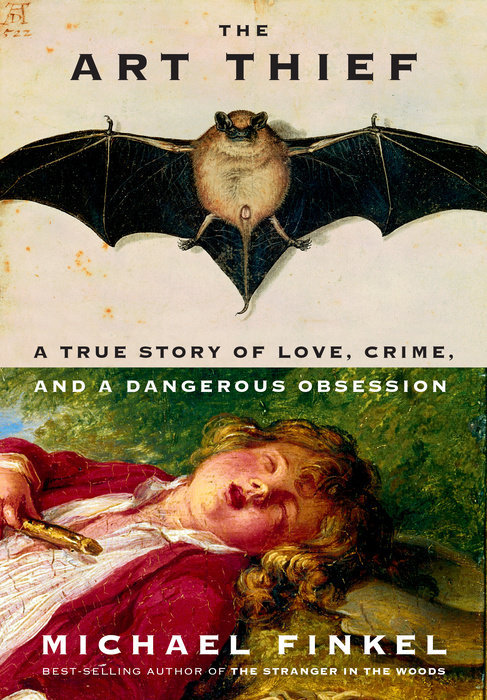


2023 Goodreads Choice Awards: Best Nonfiction
Winner: Poverty, By America by Matthew Desmond
The United States, the richest country on earth, has more poverty than any other advanced democracy. Why? Why does this land of plenty allow one in every eight of its children to go without basic necessities, permit scores of its citizens to live and die on the streets, and authorize its corporations to pay poverty wages?
In this landmark book, acclaimed sociologist Matthew Desmond draws on history, research, and original reporting to show how affluent Americans knowingly and unknowingly keep poor people poor. Those of us who are financially secure exploit the poor, driving down their wages while forcing them to overpay for housing and access to cash and credit. We prioritize the subsidization of our wealth over the alleviation of poverty, designing a welfare state that gives the most to those who need the least. And we stockpile opportunity in exclusive communities, creating zones of concentrated riches alongside those of concentrated despair. Some lives are made small so that others may grow.
Elegantly written and fiercely argued, this compassionate book gives us new ways of thinking about a morally urgent problem. It also helps us imagine solutions. Desmond builds a startlingly original and ambitious case for ending poverty. He calls on us all to become poverty abolitionists, engaged in a politics of collective belonging to usher in a new age of shared prosperity and, at last, true freedom.
Nominee: The Art Thief by Michael Finkel
For centuries, works of art have been stolen in countless ways from all over the world, but no one has been quite as successful at it as the master thief Stéphane Breitwieser. Carrying out more than two hundred heists over nearly eight years—in museums and cathedrals all over Europe—Breitwieser, along with his girlfriend who worked as his lookout, stole more than three hundred objects, until it all fell apart in spectacular fashion.
In The Art Thief, Michael Finkel brings us into Breitwieser’s strange and fascinating world. Unlike most thieves, Breitwieser never stole for money. Instead, he displayed all his treasures in a pair of secret rooms where he could admire them to his heart’s content. Possessed of a remarkable athleticism and an innate ability to circumvent practically any security system, Breitwieser managed to pull off a breathtaking number of audacious thefts. Yet these strange talents bred a growing disregard for risk and an addict’s need to score, leading Breitwieser to ignore his girlfriend’s pleas to stop—until one final act of hubris brought everything crashing down.
This is a riveting story of art, crime, love, and an insatiable hunger to possess beauty at any cost.
Nominee: 8 Rules of Love by Jay Shetty
Nobody sits us down and teaches us how to love. So we’re often thrown into relationships with nothing but romance movies and pop culture to help us muddle through. Until now.
Instead of presenting love as an ethereal concept or a collection of cliches, Jay Shetty lays out specific, actionable steps to help you develop the skills to practice and nurture love better than ever before. He shares insights on how to win or lose together, how to define love, and why you don’t break in a break-up. Inspired by Vedic wisdom and modern science, he tackles the entire relationship cycle, from first dates to moving in together to breaking up and starting over. And he shows us how to avoid falling for false promises and unfulfilling partners.
By living Jay Shetty’s eight rules, we can all love ourselves, our partner, and the world better than we ever thought possible.
Nominee: On Our Best Behavior by Elise Loehnen
Women congratulate themselves when they resist the doughnut in the office break-room. They celebrate their restraint when they hold back from sending an e-mail in anger. They feel virtuous when they wake up at dawn to get a jump on the day. They put others' needs ahead of their own and believe this makes them exemplary. In On Our Best Behavior, journalist Elise Loehnen explains that these impulses - often lauded as unselfish, distinctly feminine instincts - are actually ingrained in women by a culture that reaps the benefits, via an extraordinarily effective collection of mores known as the Seven Deadly Sins.
Since being codified by the Christian church in the fourth century, the Seven Deadly Sins - pride, greed, lust, envy, gluttony, wrath, and sloth - have exerted insidious power. Even today, in our largely secular, patriarchal society, they continue to circumscribe women's behavior. For example, seeing sloth as sinful leads women to deny themselves rest; a fear of gluttony drives them to ignore their appetites; and an aversion to greed prevents them from negotiating for themselves and contributes to the 55 percent gender wealth gap. Loehnen reveals how women have been programmed to obey the rules represented by these sins and how doing so qualifies them as "good."
This probing analysis of contemporary culture and thoroughly researched history explains how women have internalized the patriarchy, and how they unwittingly reinforce it. By sharing her own story and the spiritual wisdom of other traditions, Loehnen shows how women can break free and discover the integrity and wholeness they seek.
#nonfiction#2023 reads#goodreads#reading recommendations#reading recs#book recommendations#book recs#library books#tbr#tbr pile#to read#booklr#book tumblr#book blog#library blog#readers advisory
8 notes
·
View notes
Text
I’ve been down a rabbit hole wondering about medieval jewelry (and if I can reproduce it despite having no metalworking skills, to which the answer is mostly no) lately & I figured I would share the fruits of my museum collection searches for other medievalists/hobbyists/reenactors/nerds.
Jewelry of the 13th Century Anglo/Francosphere

TL;DR
Metals: 🟨 gold(tone)
Stones: mostly 🔵 cabochon, rarely 💠 simple cut, some carved 🗿 intaglio or cameo
Stone Colors: warm blues, emerald green, purples, burgundies, reds
Materials: enamel, 💎 gemstones (garnet, Ceylon sapphire, ruby/spinel, emerald) or glass paste imitations, ⚪ semi-precious stones (pearl, lapis, jasper, carnelian, coral, turquoise, porphyry)
Settings: bezel (oval and rectangular); ⚜️ intricate metalwork; more visible and textured metal than modern jewelry; more mixtures of stones and colors than modern tastes
Motifs: ◯ round, ✤ quatrefoil, ✙ cross, ✸ star (even numbers of points), ♣ trefoil, ❦ floral, 🐉 animals, 𝕬 inscription
Formats: brooches, ornamented clothing, rings, pendants, circlets, cuffs (rare)
A detailed look:
Some forms of jewelry that were very popular in the Roman Empire and are again today were just not the thing in the middle European Middle Ages. (Earrings, for example, seem to have barely existed. This is partially at least because ears were covered--by coifs and caps, hair, and (for women) braids or the chin strap and fillet/wimple/gorget.) In fact, a lot of the places we would put jewelry against our skin today were covered.
This left some other options:
Jewelry on Clothing
Medallions
Okay, these aren’t jewelry, strictly speaking, but they’re metalwork ornaments associated with a person.
Enamel Mitre Medallions

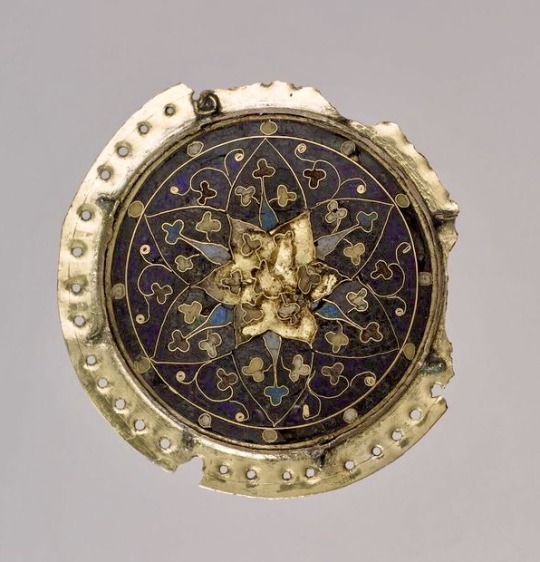
OA 3437 and OA 3438 Before 1291, Ile de France Louvre, Paris photos (c) Musée du Louvre / Stéphane Maréchalle 2015
Cloisonné and plique enamel over gold and copper, with decorative motifs of trefoils, quatrefoil, and stars in a palette of dark blue and green with accents that may once have been ruby red.
Appliqué Medallion
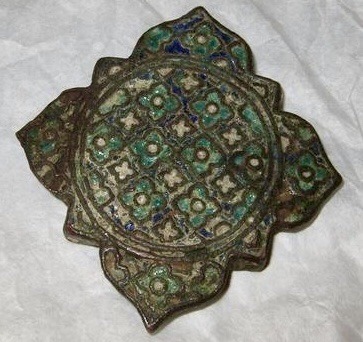
# MRR 256 13th c., Limoge Louvre, Paris photo (c) Musée du Louvre 2014
Gilded copper (though most gold is worn off) with quatrefoil champlevé enamel in emerald green, lapis blue, and white or off-white.
Brooches
Perhaps the most prevalent medieval jewelry item in the Anglo & French regions. These were worn at the shoulder for men and breast for women, often anchoring a cloak, or to close the collar. As the ornate fermail and double-ring brooch suggest, these ran the gamut from practical to incredibly decorative and ornate.
Garnet & Silver Gilt Animal Ring Brooch; Green and Blue Glass and Gilt Ring Brooch

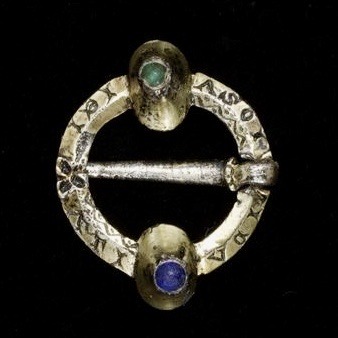
Left, # 2003,0703.1 13th century; found in Suffolk, England British Museum, London photo (c) The Trustees of the British Museum
Right, # M.28-1929 13th c., England V&A, London photo © Victoria and Albert Museum, London
Cabochon garnets or carbuncles in the gilded silver brooch (L), perhaps once paired with smaller stones in the eyes of metalwork animals that bite the pin bracket. The right brooch, also silver gilt, sports two glass paste emerald and sapphire "gems" in cabochon. It was probably a lover's token; it reads (in Lombardic-lettered French) IOSV ICI ATI VCI or "jo su[i] ici a t[o]i v[o]ici" which I might translate as "I am here with/belonging to you, look!"
Ruby & Sapphire Ring Brooch; Sapphire, Garnet, and Pearl Fermail
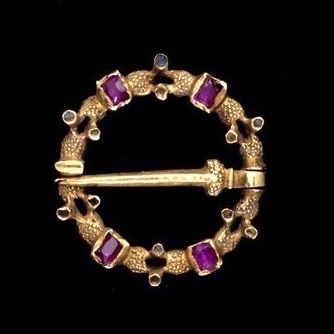
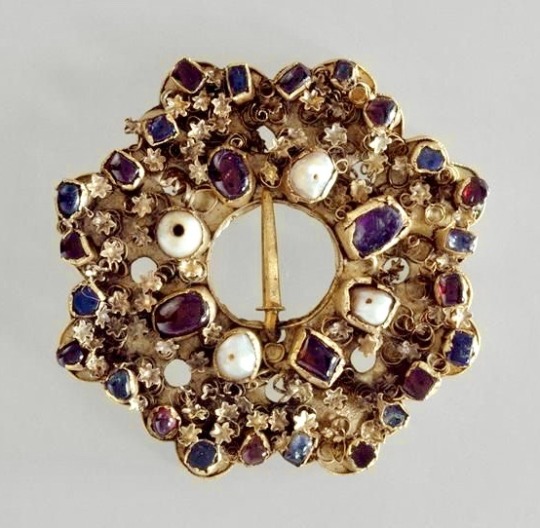
Left, # 6808-1860 1275-1300, England V&A, London photo © Victoria and Albert Museum, London
Right, # OA6287 1250-1300, France Louvre, Paris photo (c) Musée du Louvre
Blogs often claim that stones were only polished en cabochon until the 16th century, and that medieval jewelers couldn't cut gemstones. But this 13th-century gold ring brooch (left) pairs table-cut purple rubies with collet-set cabochon sapphires, and may evidence early medieval gem-cutting or reuse of Roman cut stones. The silver gilt fermail, right, includes pearl beads, garnets and sapphires both cut and cabbed, and one glass paste cabochon. Both are intricately textured, with punchwork (L) and floral metalwork, probably cast and then attached (R).
Double Ring Brooch with Sapphire and Glass "Emeralds"
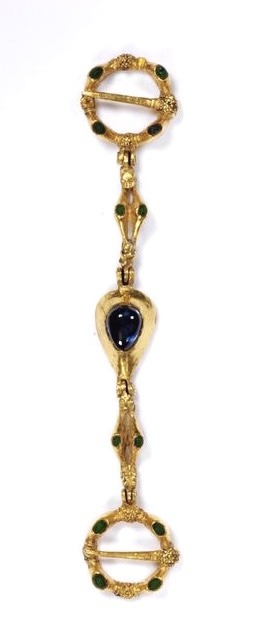
# M.26-1993 13th c., England V&A, London photo © Victoria and Albert Museum, London
This gold double brooch is so small they think it was for a woman or child. Central sapphire cab is flanked by glass paste "emeralds" in bezel settings and metalwork featuring two animal heads.
Jewelry on the Body
Rings
Many are probably familiar with the signet ring, used for pressing into sealing wax, which could be intaglio-carved gemstone or metals. There were also a number of decorative and/or talismanic gemstone rings.


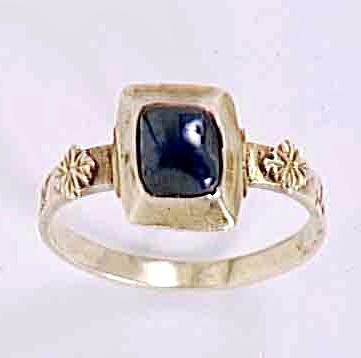
LtR:
#M.7-1929 | #M.180-1975 | #OA 11265 1250-1300, England | 1250-1300, Engl/France | 13th c., Engl/France V&A, London | V&A, London | Louvre, France photos L&C © Victoria and Albert Museum, London | R (c) Musée du Louvre
Sapphire in gold is the name of the game when it comes to rings in the thirteenth century; even the purple stones on the left are purple sapphires. (Sapphires were said to aid chastity, purity, and the effectiveness of prayer.) For larger stones, the bezel often has claws added (L); the central ring is an example of a full claw setting that modern viewers might find surprisingly tall. Naturalistic flourishes are added (C & R); these might be pre-cast then attached to the base (R).
Pendants
We equate pendants with necklaces, but their medieval applications also included wear as badges, from headpieces, and on horse decorations.

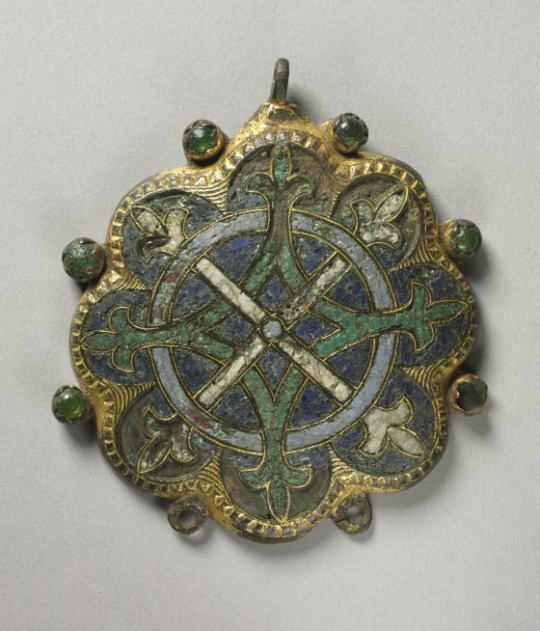
Left, bloodstone jasper cameo in silver setting # MRR 218 1100-1300, France? Louvre, Paris photo (c) Musée du Louvre / Jean Blot 1984
Right, champlevé enamel, gilt copper, and paste "emerald" (harness) pendant # 1976.169 13th c., France Cleveland Museum of Art, Cleveland photo CC0 Open Access
Statue Jewelry
From here, we get into the really ridiculous stuff; the previous categories could be relatively everyday (as much as ornamentation reserved exclusively for the wealthy can be an everyday thing) but the following examples are astonishing displays not necessarily for wear.
"La Couronne" de Vierge et l'Enfant d'ivoire de la Sainte-Chapelle
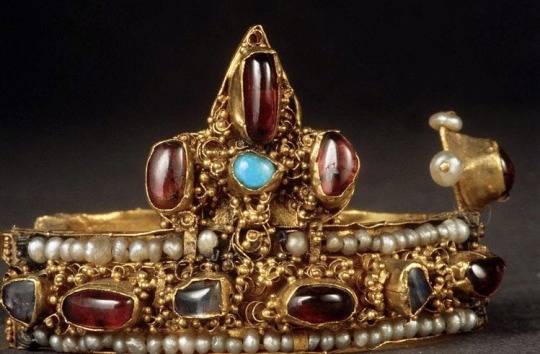
# OA 57 B 1250-1300, France Louvre, Paris photo (c) Musée de Louvre
This was not even a crown for a person, but rather for a painted ivory statue of the Virgin Mary, holding her infant son. (Though circlets, even set with stones, were sometimes worn as part of women's head dress.) It's incredibly ornate gold, set with pearls, garnets and rubies, sapphires, and turquoise (?) en cabochon.
Anneau de Saint-Denis

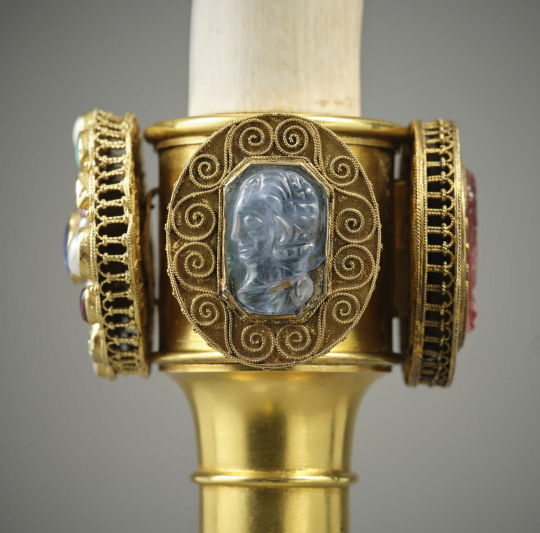


# MS 85 BIS 1200-1215, France Louvre, Paris photos (c) Musée du Louvre / Daniel Arnaudet 1990
This astonishing piece, which is ring-sized but now displayed as a cuff on an ivory hand, is made of gold and displays every possible gemstone appearance characteristic of the period. The front piece has a central sapphire and is surrounded by quartz with red backing (mimicking ruby/garnet), amethysts, pearls, and sapphires, some set on yellow backing (mimicking turquoise?). Most are en cabochon on this face, but two are faceted and two intaglio. Were this not enough, the three other 'faces' of the ring are set with gems as well, two cameos (probably sapphire and garnet?) and one amethyst intaglio set in ornate gold filigree.
#medieval#jewelry making#lapidary#history of fashion#historical jewelry#1200s#reenactment#England#France#enamel jewelry#ring brooch#fermail#intaglio#cameo#gemstones#infodumping#now time to go to the bead store#material history#you would think this is for my research or academically relevant but it's not I just couldn't stop looking at shiny things help#photos not mine#photos for educational purposes and not for commercial reproduction#louvre#v&a museum#british museum#cleveland museum of art
38 notes
·
View notes
Text
One of the most remarkable true-crime narratives of the twenty-first century: the story of the world’s most prolific art thief, Stéphane Breitwieser. In this spellbinding portrait of obsession and flawed genius, the best-selling author of The Stranger in the Woods brings us into Breitwieser’s strange world—unlike most thieves, he never stole for money, keeping all his treasures in a single room where he could admire them. For centuries, works of art have been stolen in countless ways from all over the world, but no one has been quite as successful at it as the master thief Stéphane Breitwieser. Carrying out more than two hundred heists over nearly eight years—in museums and cathedrals all over Europe—Breitwieser, along with his girlfriend who worked as his lookout, stole more than three hundred objects, until it all fell apart in spectacular fashion. In The Art Thief, Michael Finkel brings us into Breitwieser’s strange and fascinating world. Unlike most thieves, Breitwieser never stole for money. Instead, he displayed all his treasures in a pair of secret rooms where he could admire them to his heart’s content. Possessed of a remarkable athleticism and an innate ability to circumvent practically any security system, Breitwieser managed to pull off a breathtaking number of audacious thefts. Yet these strange talents bred a growing disregard for risk and an addict’s need to score, leading Breitwieser to ignore his girlfriend’s pleas to stop—until one final act of hubris brought everything crashing down. This is a riveting story of art, crime, love, and an insatiable hunger to possess beauty at any cost.

6 notes
·
View notes
Photo

Le @casinosmontecarlo : une nouvelle fois été récompensé par ses pairs à l’occasion du salon ICE London, le grand rendez-vous international des professionnels du Jeu, qui s’est tenu à Londres du 6 au 9 février. Deux prix ont été décrochés face aux plus grands opérateurs de jeu au monde : « Best Casino Operator », aux International Gaming Awards, et « Best Casino Restaurant » pour le Train Bleu, aux European Casino Awards. Avec le prix de « Best Casino Restaurant », l’European Casino Association honore la tradition de l’excellence gastronomique du mythique Train Bleu, portée désormais par Richard Rubbini. Au-delà de son décor qui invite au voyage, de sa large carte bistrot à la française, une attention toute particulière est portée aux envies des joueurs, pour une offre sur-mesure. Le prix du « Best Casino Operator » délivré par les International Gaming Awards met en lumière la capacité du Casino de Monte-Carlo à créer des expériences sur-mesure sans cesse renouvelées. A cette occasion, Stéphane Valeri, le nouveau Président Délégué de Monte-Carlo Société des Bains de Mer, qui a pris ses fonctions récemment, a réagi : « Je tiens à féliciter toutes les équipes du Casino de Monte-Carlo pour ces deux prix qui mettent une fois de plus en valeur l’excellence de notre savoir-faire et qui font rayonner notre destination à l’international. De même, le renouvellement de la certification Jeu Responsable permet de positionner toujours mieux nos Casinos, grâce aux valeurs qui font notre ADN au sein du Resort Monte-Carlo Société des Bains de Mer ». #mymontecarlo #casinomontecarlo #montecarlosbm #monaco #gastronomie #awards #best #luxurylifestyle #cotedazurfrance #visitmonaco (à Casino Monte Carlo) https://www.instagram.com/p/Co9tP6NIUC0/?igshid=NGJjMDIxMWI=
#mymontecarlo#casinomontecarlo#montecarlosbm#monaco#gastronomie#awards#best#luxurylifestyle#cotedazurfrance#visitmonaco
2 notes
·
View notes
Photo
It's worth seeing. There's also a memorable scene where Stéphane Rideau is running around playing rugby shirtless in just a lovely pair of short white shorts. Such longing.










Wild Reeds (1994)
14K notes
·
View notes
Video
youtube
Mixed Pairs Couple Of Bodybuilding Karen FELIX and Stéphane PELLOQUIN
0 notes
Text
When asked what solution had been employed to manufacture the fourth stage for the final Vega flight, Arianespace CEO Stéphane Israël said, “I have no comment to make on what you have heard.”
0 notes
Text
Hémicycle, Paris, 4/16/24
exterior –5 Rue de Bourgogne, 75007 Paris, France Hémicycle, opened in August 2023 as a new restaurant from owner Stéphane Manigold under the direction of Chef Flavio Lucarini and Pastry Chef Aurora Storari. It only took four months to earn a one Michelin star rating in addition to Storari winning the Passion Dessert Award. The small place offered a 3, 4 or 6 course lunch menus with pairings as…

View On WordPress
#Aurora Storari#dining#eating#Flavio Lucarini#Frankie#Hémicycle#image#lunch#meal#menu#Michelin#Paris#photo#picture#restaurant#review
0 notes
Text




📣 [CONFÉRENCE] De l'utilité et de l'impact des explorateurs. À l'intention de ceux qui en douteraient. 👊 Explications ⤵️
🚸 Marion Fellrath est professeur des écoles dans le 20ème arrondissement à Paris. Au cours de cette année scolaire, et de ses projets pédagogiques, elle a fait travailler ses élèves sur la Société des Explorateurs Français.
✨ L'opportunité pour elle de leur donner le goût de l'ailleurs et de la découverte.
💬 Vendredi dernier, je suis allé voir Marion et ses élèves. Et voilà ce qu'elle écrit de cette rencontre forte, intense et vivifiante :
« Nous avons donc eu la chance de recevoir Stéphane secrétaire général de la Société des Explorateurs Français qui est venu leur parler d'une figure incontournable de l'exploration : Paul-Émile Victor
C'était un moment d'échanges fascinant, où il a tout fait pour leur expliquer la démarche de cet explorateur/ethnologue : c'est celui qui se fond dans un territoire ou une population, qui ne juge pas, qui observe et qui cherche à comprendre.
Les enfants buvaient ses paroles.
Une fois la stupéfaction passée face aux coutumes qui leur semblaient, dans un premier temps, bien étranges, la magie a opéré, et l'espace d'un instant, ils étaient ailleurs.
Le pouvoir d'un bon récit me fascinera toujours. Ils attendent tous lundi avec impatience pour poursuivre cette expérience en lisant la BD généreusement offerte par Stéphane !
Merci pour ce moment inoubliable ! ».
Post-scriptum : Merci à Marion, ses élèves, son établissement pour toutes ces bonnes ondes. Et encore bravo pour son soutien à Henry Bizot qui a permis à Marion et ses élèves de financer leur voyage à La Rochelle. L'opportunité de constater que la terre n'était pas plate (sic) en écoutant Isabelle Autissier, navigatrice et conteuse hors-pair.
#stéphane dugast#aventure#exploration#stéphanedugast#polaire#voyage#explorateur#livre#conférence#paul émile victor#paul-émile victor#école#éducation
0 notes